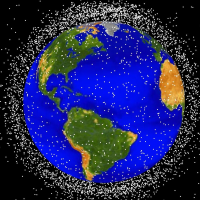Future Increase in Space Debris Collisions Will Pose Danger to Satellites
 Low Earth orbit space debris (graphic: NASA)
Low Earth orbit space debris (graphic: NASA)
It is only a matter of time before nations begin unnecessarily losing their satellites in orbit around the Earth, unless something is done about the growing threat of space junk.
A new study by the Inter-Agency Space Debris Coordination Committee (IASDCC) warned that certain satellite orbits will become dangerous over the next 200 years as discarded hardware keeps accumulating.
Researchers concluded that catastrophic collisions could occur every five to nine years from abandoned rocket stages, broken satellites and other debris striking important operational equipment. The chances of these collisions range from 19% to 36%, according to the committee.
Currently, there are nearly 30,000 objects about four inches in size or larger floating around the planet.
But that’s not nearly all of it. There are another 670,000 pieces less than half an inch in size, and more than 170 million tinier fragments (.03 inches) up there—all of which can cause harm to satellites and spacecraft.
The study included six separate investigations that were conducted by NASA, the European Space Agency (ESA), and the British, Indian, Italian, and Japanese space agencies. Each arrived at similar conclusions.
Experts have debated how to clean up earth’s cluttered orbit. One idea from the United Kingdom involves a small harpoon-like device that could be fired at the bigger chunks of space debris to force them out of orbit so that they would burn up in the atmosphere. The Swiss Federal Institute for Technology in Lausanne (EPFL) is developing a $10.6 million “clean-up” satellite that would travel through space picking up debris and then jettison itself into the atmosphere to self-destruct. And the U.S.’s Defense Advanced Research Projects Agency (DARPA) is, through its SpaceView program, calling on amateur astronomers for help: the agency is supplying its freelance operators with time-share telescopes, hardware upgrades and financial support in its creation of a “neighborhood watch” for space.
The IASDCC researchers developed their dire predictions using an assumption that may be viewed as overly optimistic: 90% compliance by space agencies with a rule requiring them to remove their equipment from orbit following completion of each mission; and that there be no more explosions of fuel tanks and old batteries in space.
“It is fair to say this is an optimistic look forward, and the situation will be worse than what we presented in the study,” study participant Dr. Hugh Lewis of the UK Space Agency told the BBC.
-Danny Biederman, Noel Brinkerhoff
To Learn More:
Space Debris Collisions Expected to Rise (by Jonathan Amos, BBC News)
Focus on Growing Threat of Space Debris (European Space Agency)
IADC Study: Stability of the Future LEO Environment (Inter-Agency Space Debris Coordination Committee) (pdf)
Space Debris must be Cleared, Warn European Experts (The Guardian) (video)
Chinese Space Debris Hits Russian Satellite, Scientists Say (by Melissa Gray, CNN)
Orbital Debris FAQs (NASA Orbital Debris Program Office)
Swiss Plan “Janitor Satellite” to Clean Up Space Junk (by Noel Brinkerhoff, AllGov)
The Ever-Growing Problem of Space Junk (by Noel Brinkerhoff and David Wallechinsky, AllGov)
The Growing Problem of Space Junk (by Noel Brinkerhoff, AllGov)
- Top Stories
- Unusual News
- Where is the Money Going?
- Controversies
- U.S. and the World
- Appointments and Resignations
- Latest News
- Trump to Stop Deportations If…
- Trump Denounces World Series
- What If China Invaded the United States?
- Donald Trump Has a Mental Health Problem and It Has a Name
- Trump Goes on Renaming Frenzy






Comments